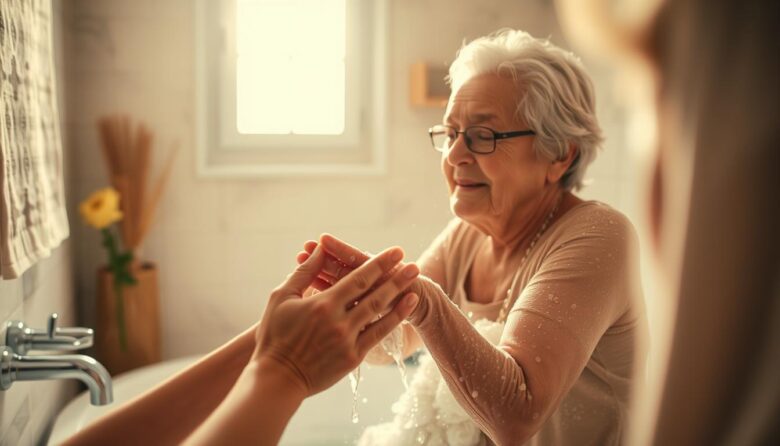As people age, daily tasks like bathing or grooming can become challenging. Maintaining cleanliness is essential for preventing health issues and preserving dignity. This article explores practical ways to support aging adults while respecting their independence.
Skin infections and dental problems often arise when hygiene needs aren’t met. Caregivers play a critical role in addressing these risks through consistent routines. Simple adjustments, like using non-slip bath mats or adaptive grooming tools, enhance safety and comfort.
Effective senior care involves collaboration. Open communication helps tailor routines to individual preferences. For example, choosing morning or evening baths based on the person’s energy levels can reduce stress.
This guide will highlight evidence-based strategies for caregivers. You’ll learn how small changes create meaningful improvements in quality of life. We’ll also discuss balancing assistance with autonomy to foster confidence for both seniors and their support teams.
Understanding the Importance of Elderly Personal Hygiene Care
The connection between cleanliness and well-being grows stronger as individuals enter later life stages. Aging bodies face increased vulnerability to infections like pneumonia or urinary tract issues due to weaker immune responses. Simple hygiene practices act as frontline defense against these preventable health risks.
Beyond physical health, consistent routines boost confidence and social engagement. Neglected self-care often leads to isolation as individuals may avoid interactions due to embarrassment. This emotional toll underscores why personal care directly impacts mental wellness.
Caregivers play a vital role in disease prevention through observation. Regular checks for skin changes or oral conditions allow early intervention before minor issues escalate. Documenting these observations helps medical teams tailor senior care plans effectively.
Proper cleanliness also enhances treatment outcomes for chronic illnesses. Well-maintained skin absorbs medications better, while oral hygiene reduces respiratory infections. These tips empower families to help seniors maintain independence longer, reducing reliance on intensive support systems.
Addressing Hygiene Challenges with Compassion and Respect
Navigating changes in daily routines requires sensitivity to preserve dignity while addressing essential care needs. Small but noticeable shifts in habits often signal deeper issues requiring thoughtful intervention.
Recognizing Early Signs of Hygiene Decline
Watch for subtle shifts like increased body odor or stained clothing. Missed dental routines or unwashed hair often indicate physical limitations. Bathroom accidents or reluctance to socialize may reveal unspoken struggles.
Document patterns discreetly before addressing concerns. Sudden changes might point to medical problems needing professional evaluation. Tracking details helps separate temporary issues from persistent challenges.
Initiating Open Discussions About Care Needs
Choose calm moments for conversations, avoiding confrontational language. Start with observations: “I noticed your favorite shirt needed washing – can we brainstorm solutions?” This approach invites collaboration.
Respect preferences by offering choices. Ask if they prefer family help or professional support for specific tasks. Discuss caregiver gender preferences and privacy boundaries to build trust.
Frame changes as teamwork: “Let’s find ways to make mornings easier.” Regular check-ins adapt plans as care needs evolve, maintaining autonomy while ensuring safety.
Incorporating Personal Routines for Familiarity and Comfort
Consistency forms the foundation of effective caregiving strategies. Maintaining familiar schedules helps individuals feel secure during transitions, especially when adjusting to new support systems. Matching existing patterns reduces confusion and builds trust between caregivers and those receiving assistance.
Maintaining a Consistent Daily Schedule
Align activities with established preferences whenever possible. If morning bathing has been a lifelong habit, preserve this timing to create continuity. Use preferred soaps or towels to reinforce comfort through sensory familiarity.
Document routines in a shared journal when multiple caregivers assist. Note preferences like water temperature or specific grooming tools. This ensures everyone follows the same patterns, minimizing disruptions.
Introduce changes gradually when safety requires adjustments. Pair explanations with reassurance: “Let’s try this shower seat together – it’ll make your routine easier.” Involving individuals in product selections maintains their sense of control.
Cultural practices influence many daily rituals. Respect traditions around time of day for washing or preferred cleansing methods. Collaborate to adapt these customs safely without erasing meaningful habits.
Adjusting Bathing Frequency for Health and Safety
Balancing cleanliness with skin protection requires strategic planning. Aging skin becomes thinner and more prone to irritation, making overwashing a common concern. Experts recommend two full shower sessions weekly for most individuals, supplemented by targeted cleaning between sessions.
Using Full Showers Versus Sponge Baths
Complete bathing effectively removes sweat and bacteria but can strip natural oils. Limit full-body washing to preserve moisture barriers. For daily maintenance, focus on high-risk areas like underarms and groin using warm water and gentle cloths.
Tailoring Cleaning Schedules Based on Needs
Modify routines after evaluating activity levels and medical factors. Those managing incontinence benefit from immediate cleansing during changes to prevent skin breakdown. Nightly washing before bed reduces bacterial growth during sleep hours.
Test water temperature with a thermometer to prevent burns. Pat skin dry instead of rubbing, paying attention to skin folds. Track changes in texture or redness to adjust methods promptly. Document routines to identify patterns and optimize safety measures.
Ensuring Privacy and Dignity in Personal Care
Maintaining dignity during intimate moments requires thoughtful approaches. Simple strategies like partial towel coverage during bathing help preserve modesty while ensuring thorough cleaning. These ways of balancing privacy with care needs foster trust between caregivers and those receiving support.
Respecting Individual Preferences
Always ask permission before assisting with sensitive tasks. Explain each step clearly – “May I adjust the towel now to wash your shoulder?” This gives your loved one control over the pace and process.
Some individuals prefer caregivers of specific genders. Honor these requests when possible through family arrangements or professional services. Keep rooms warm and doors closed to create secure spaces during personal care routines.
Document preferences in a shared notebook if multiple helpers assist. Small adjustments, like using robes for coverage between tasks, make big differences in comfort. Prioritizing these needs helps maintain confidence during vulnerable moments.



